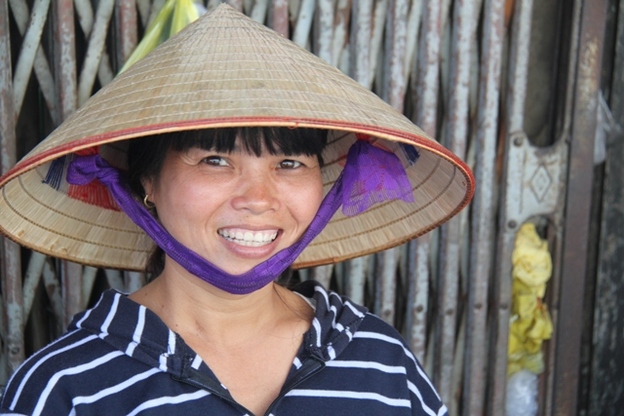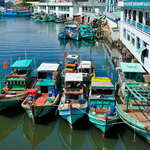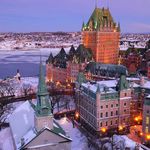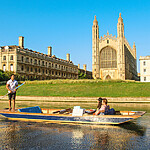Andy Mossack reveals a fascinating Ho Chi Minh City Insider travel guide exclusively for TripReporter.
Early morning in Ho Chi Minh City, (or Saigon as I and the locals still prefer to call it) and I’m feeling very sweaty. Admittedly, it is very humid, but my current condition is the result of a brave attempt to complete my first challenge of the day; to get across Nguyen Thi Minh Khai Street in one piece.
Fortunately, I have Heuw with me, a veteran of Saigon traffic. “Just walk slowly straight across, don’t stop whatever you do” he tells me calmly ” they’ll simply drive around you.” Sound advice I say to myself, as one moped buzzes past laden with a complete family of four, a basket of kitchen utensils and a rolled up carpet.
The traffic is jaw dropping. A sea of mopeds and motorbikes running over ten rows deep. But I’m not fazed. Taking Heuw’s advice, we slowly make our way across as magically, like the parting of the Red Sea, a gap appears and our destination edges ever closer. I almost get side swiped by a flower vendor, his bike invisible underneath a meadow of petals, itself narrowly missing a fellow rider hauling a sideboard tied around his waist. Unfazed, I walk on and meet up with Heuw on the other side.
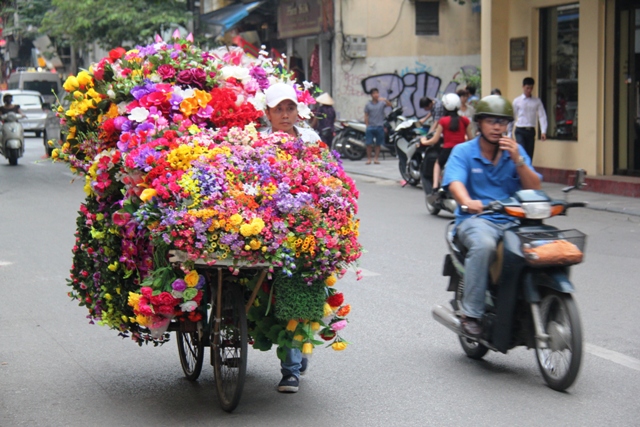
This is a world away from my overnight stay at Ho Chi Minh City’s latest luxury hotel, The Reverie Saigon, towering 50 floors above District 1, the city’s historic downtown area. But I want a taste of the real Saigon. To see the city from a local’s perspective. And this was certainly an eventful opening to my Ho Chi Minh City insider travel guide experience.
There are several sights close together in District 1; many reflecting the city’s French colonial past; the Opera House, The Notre Dame Cathedral, the stunning Saigon Central Post Office (designed by Gustave Eiffel no less) the former Presidential Palace now named The Reunification Palace, the War Remnants Museum and of course Ben Thanh Market with its 3,000 stalls.
But I wanted to see the Saigon that is off the tourist treadmill and Heuw was leading the way.
Xom Chieu Market, District 4
Just a short drive from downtown, across Khanh Hoi bridge and any western faces are left behind as we make our way into Xom Chieu market, a space simply filled with colour, aroma and the sound of bartering.
“These are all housewives” says Heuw “out to buy fresh ingredients for dinner. It’s a ritual to haggle, not for a better price particularly, but to put some interest into their day!”
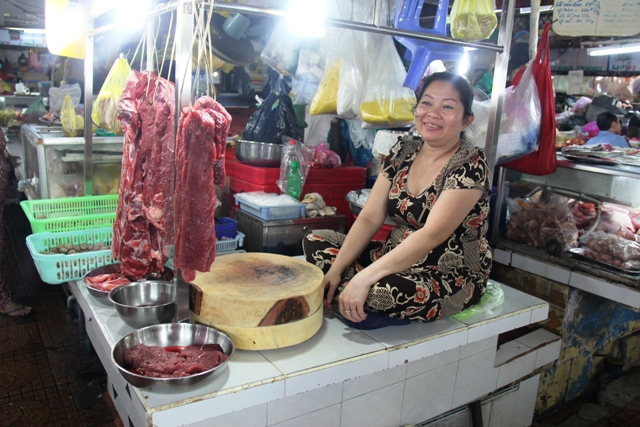
All around me vast piles of coriander, mint and Asian basil are competing aromas. A conical hat peeks out from behind a pile of water spinach known as Morning Glory and a hand materialises and offers me a bunch to taste. The hat and the hand belong to a young, beaming Vietnamese girl “You try!!” “look look!” but I’m too slow, and she’s vanished again behind the mint to attend to more customers.
I am really loving this.

We walk into the fish section and there is not a cube of ice anywhere. In my head I am thinking woops this doesn’t look too healthy but, almost as if he has read my mind, my guide pipes up “there isn’t any ice around the fish here because it is sold so quickly. It was probably only caught under an hour ago.”
I reluctantly tear myself away from the market armed with a bag of freshly roasted monkey nuts and the less scenic image of a lady whose sole job was to snip off frogs’ heads with a giant pair of scissors. If it was real Saigon life I was looking for I had well and truly found it.
Tan Thuan bridge, District 7
A short drive and we are in District 7, a relatively new area of the city which just seven years ago was predominantly rice fields. Today it is earmarked as Saigon’s growing technology area, but I’m here to visit some old boats. Docked all along the channel next to the Saigon River are ancient wooden junks stocked up to the brim with fruit and vegetables. these are farmers up from the Mekong Delta” says Heuw “the farmers don’t just sail up the river to sell their produce, all the family live on these boats too.
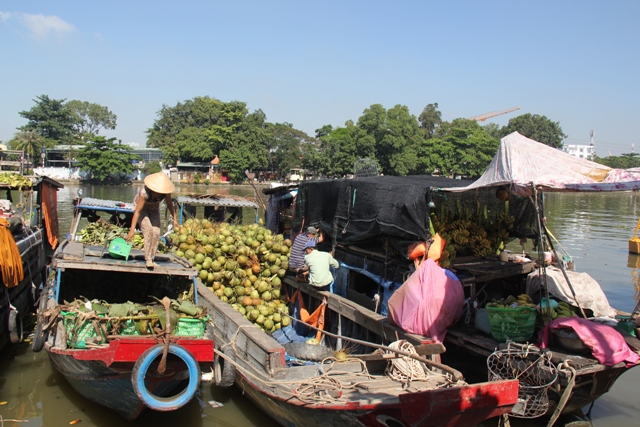
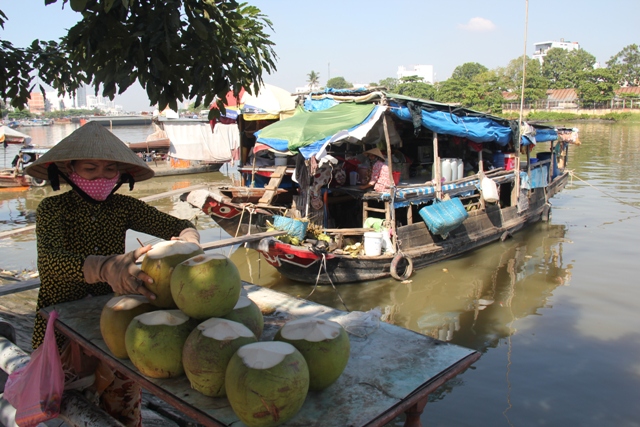
As we stroll along the waterfront another conical hat emerges from behind a pile of bananas and an even bigger pile of giant coconuts to serve a waiting pedestrian. It seems business is good, but the living conditions on the boats seems far from ideal.
Deeper into District 7 we come to Ho Ban Nguyet Park and Crescent Park, an area known as Garden City. It’s an area of lovely water fronted green spaces; locals are practicing Tai Chi, or out for a romantic walk along the riverfront. One happy bride and groom are posing for their wedding photos, a ritual always done in Vietnam some three months before the actual wedding.
Coffee time
Time for a coffee break, and there’s one thing you can be sure of in Vietnam you won’t be short of choices of coffee and places to drink it. The French may have introduced Ca Phe to Vietnam, but the Vietnamese have created a whole new book of recipes. We find a small cafe and Heuw introduces me to the locals’ favourite; a cup topped with a metal drip filter called a phin, and filled with ground beans and hot water. The very strong brew is drunk either black or with added condensed milk which I find quite sweet. Either way, they plonk in some ice cubes and slurp it up. Delicious.

The best Pho in Saigon
Back downtown in District 1 we’re heading for Pho Hung on Nguyen Trai Street, “the best Pho in Saigon” a bold claim from Heuw, but let’s face it, he ought to know. Pho (pronounced fur) is Vietnam’s national dish and you will be hard pressed to find a bad one This stunningly delicious dish is a large bowl of broth and noodles into which you put slices of beef brisket (Bo) or chicken (Ga) followed by onions, basil, coriander, chilli’s and fresh lime or lemon juice.
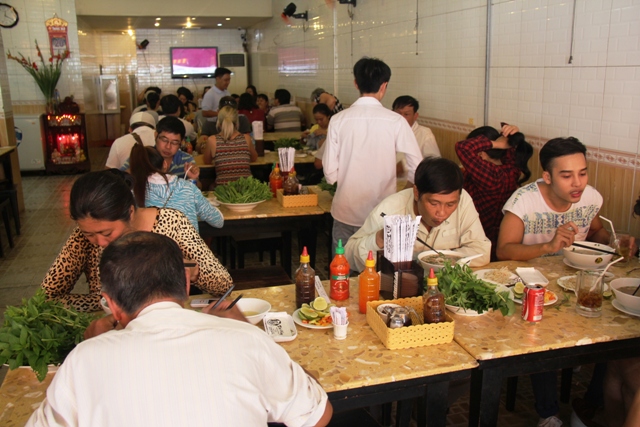
Pho Hung is rammed, with lots of locals, always a good sign in my book; long trestle tables lined with stools and steaming bowls of Pho everywhere. We spot a gap, all the incentive we need and grab our places.
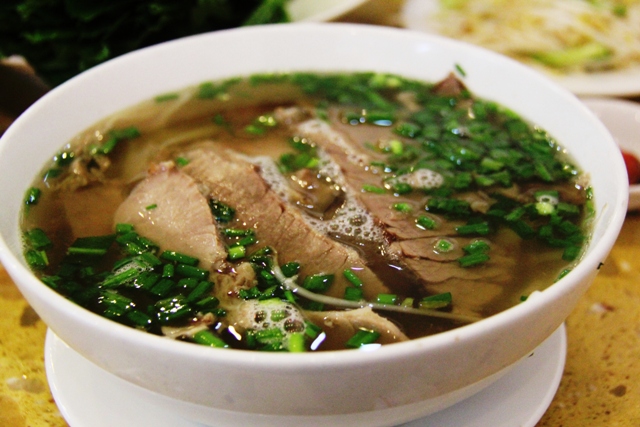
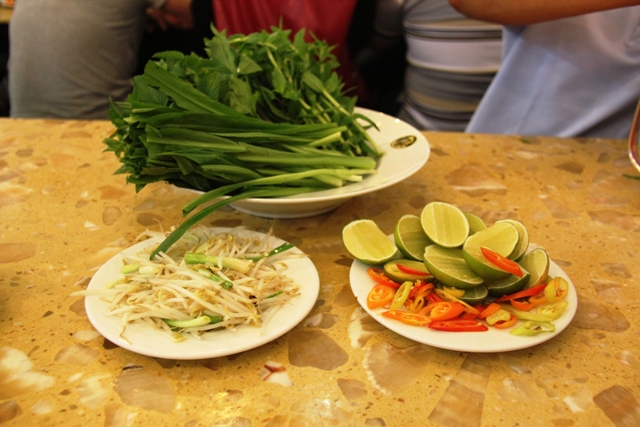
There are only two choices to make, large bowl or very large bowl and within minutes we have two steaming bowls of brisket Pho and a dish of fresh trimmings to help ourselves with. It is utterly delicious, and easily the best pho I have eaten since I arrived, and at just £4 for the two including a cold drink incredible value.
Phu Nhuan’s alley walk
After lunch we leave downtown once more for the nearby twisty alleyways of the Phu Nhuan district, an area I’m promised, quite different from what I’ve seen so far. Phu Nhuan is considered by many to be the historical centre of Saigon because of its proximity to the other districts surrounding it. Its alleys, squeezed between two main roads are havens of tranquility a world away from the bustle of Saigon traffic. Mai Văn Ngọc Street is unlike all the others because it runs right along the side of Saigon’s railway track.
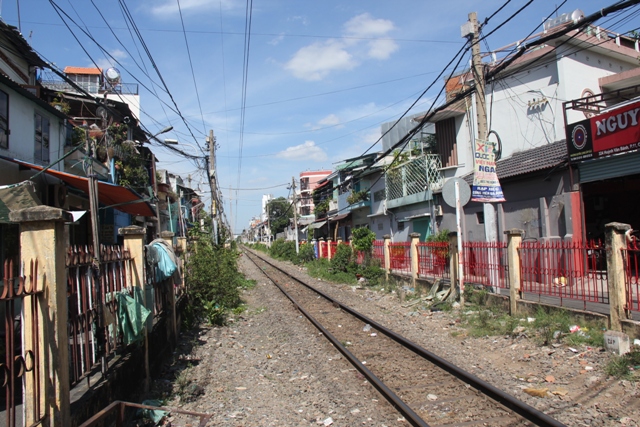
As I stroll down this narrow lane, its occupants give me an almost perfect snapshot of authentic Saigonese life; birdsong comes from a house, its shuttered front wide-open to catch whatever ever breeze prevails, a hairdresser’s next door is full of chattering customers, another house offers up an aroma of cooking, then a bike garage, a fruit shop, a cafe and then, just one man sitting on a chair between two empty ones.
Waiting for some friends perhaps? He smiles and waves at me, another example of just how friendly I find the Vietnamese. All of this tableau is to my left, almost within touching distance of the rail track to my right, separated only by a low wall and bright red railings.
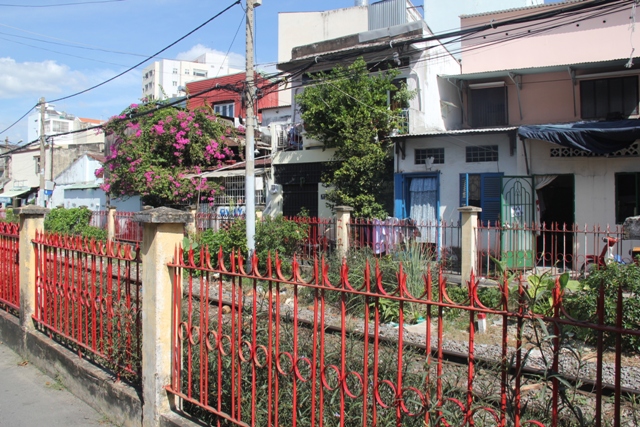
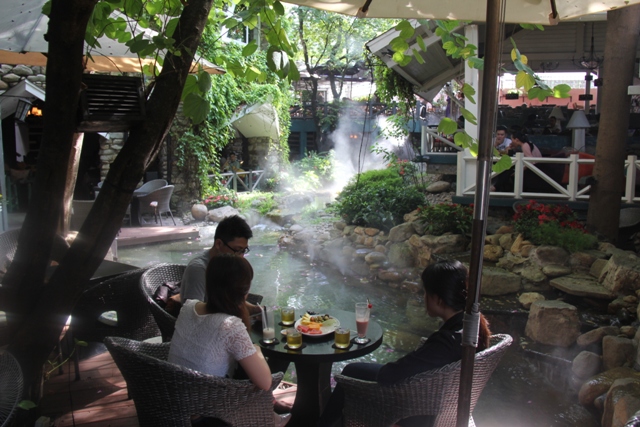
There is a real bohemian feel here, an eclectic mix of wealthy and poor, traders and dwellings all living side by side. Then, perched at the end, an unexpected bonus; the Mien Dong Thao Cafe, a delightful coffee oasis of streams, pools and waterfalls, the perfect way to finish a walk.
Echoes of Conflict
Over a coffee Heuw tells me of his memories of the Vietnam War. ” My father was a pilot for the South Vietnamese air force and was imprisoned after the war for 4 years. We had to leave the city and live in the jungle. I remember as a young boy having to walk the ground around our home for unexploded bombs and sell them to earn money.”
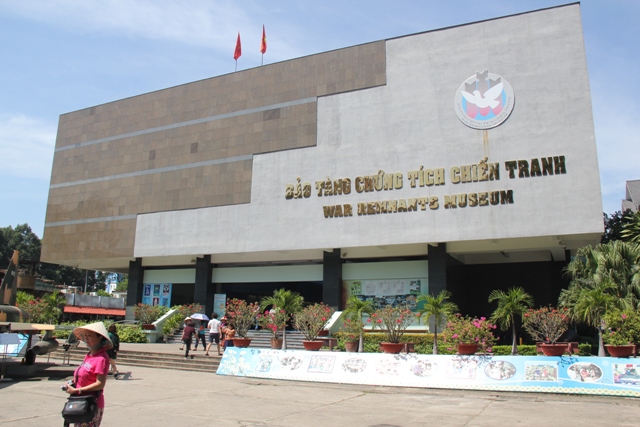
It is a disturbing tale, and around Saigon there are still many echoes of the conflict to be found. The War Remnants Museum tells a grim tale of the horrors of the war. I am reminded by Heuw it is told from a communist perspective but even so, it is a harrowing experience. As are the Cu Chi Tunnels, part of the Viet Cong’s 250 kilometre long tunnel network which is just an hour’s drive from Saigon.
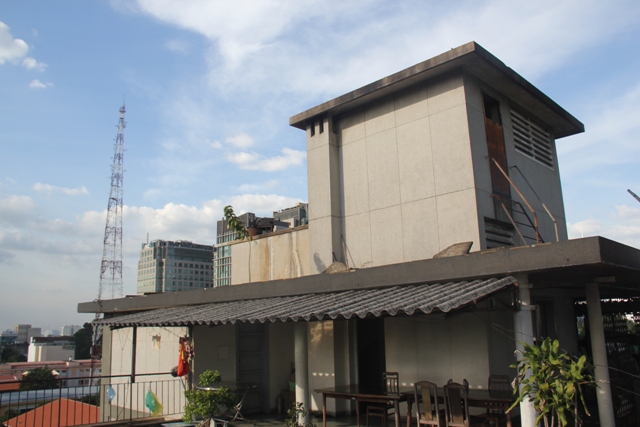
The famous USA Embassy compound building is no more, but you can visit the former CIA safe house building, where in 1975, the last USA helicopter took off in the fall of Saigon leaving the South Vietnamese to their fate. It is now an office block at 22 Lý Tự Trọng Street. You might even get lucky and be allowed up on the roof if you ask the security guard politely as I did.
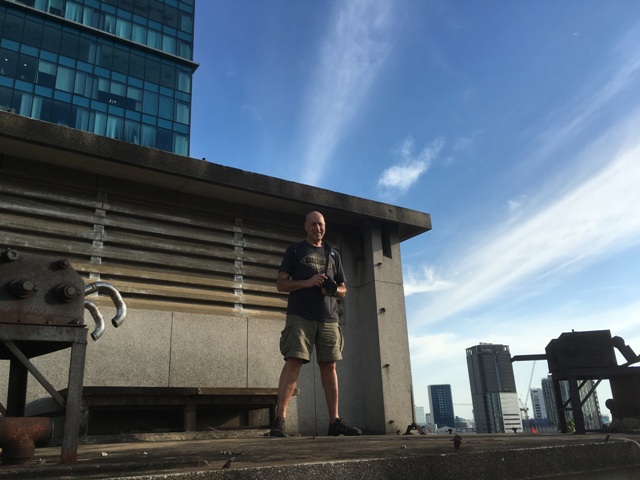
Across from here is the famous Caravelle Hotel where the world’s war press used to attend briefings up on the roof terrace. The terrace is now a cocktail bar called Saigon Saigon, great cocktails and a glorious view particularly at night.
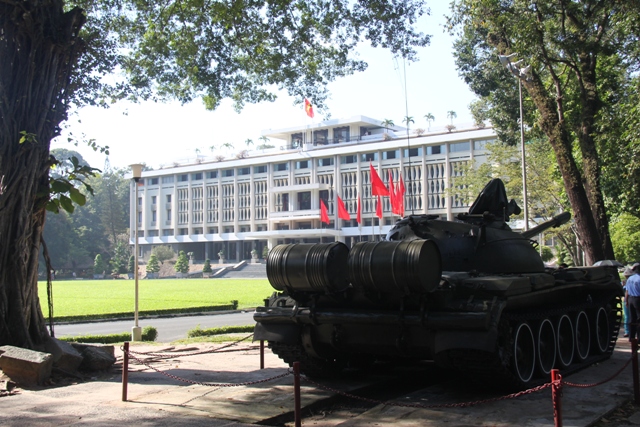
The Reunification Palace is another landmark, immortalised in the photo of North Vietnamese tanks crashing through the gates. The Palace is a memento of sixties architecture, it’s rooms frozen in time and well worth a stroll around. Two tanks still sit on the lawn as a final reminder.
My Ho Chi Minh City Insider travel guide has for me put even more colour on a city reborn after such a turbulent past. Yes you can visit Saigon’s typical tourist hot spots, but uncovering the real Saigon is an experience not to be missed.
As long as you survive crossing the road of course.
All images of Ho Chi Minh City (Saigon) (c) Andy Mossack
Read more of Andy Mossack’s tour of Vietnam including Hello to Hanoi, Hoi An, Hanoi and Ha Long Bay.
More information on this Ho Ch Minh City insider travel guide
The bespoke travel experts Experience Travel Group (+44 203468 6268) offer a 10-day tour of Vietnam from £2,567 per person, including flights, transport, accommodation and selected excursions.
Getting to Vietnam
Vietnam Airlines offers the UK’s only nonstop flights to Vietnam, with six flights per week from Heathrow to Hanoi or Ho Chi Minh City on new Boeing 787-9 Dreamliners – and excellent onward connections via its comprehensive network of over 40 destinations in Asia, including 23 within Vietnam and Indochina. Return fares to Ho Chi Minh City or Hanoi currently start from £391 or £425 per person respectively, inclusive of taxes.
UK Airport car parking: I Love meet and greet offers valet parking at Gatwick, Stansted and Heathrow airports. Costs vary throughout the year with a week’s parking at Gatwick starting from £78. Book atwww.ilovemeetandgreet.co.uk

